What we’re thinking
Progress propositions are bundles of supplementary resources – a proposed series of progress-making activities and a progress resource mix – offered by progress helpers to help seekers reach their progress sought. Ultimately aiming to maximise a seeker’s recognition of value.
Progress propositions – supplementary resources aiming to reduce a seeker’s lack of resource, increasing their judgements of progress potential and reached, and ultimately value recognised, for some specific progress sought Share on XFundamentally, a proposition addresses a progress seeker’s lack of resource progress hurdle. Although their existence introduces five new hurdles to be minimised.
We find propositions sitting on an enabling-relieving continuum. Their position is driven by who performs the majority of the progress-making activities. It also informs the composition of the progress resource mix. As well as aspects of non-functional progress supported.
But, in reality, a proposition offers to help a seeker reach a state of progress offered. That often differs from the seeker’s progress sought. So a seeker needs to judge if that is sufficiently close to progress offered to make a progress attempt.
And we note that when engaging a proposition, progress attempts become a joint endeavour. With value now emerging as an act of co-creation.
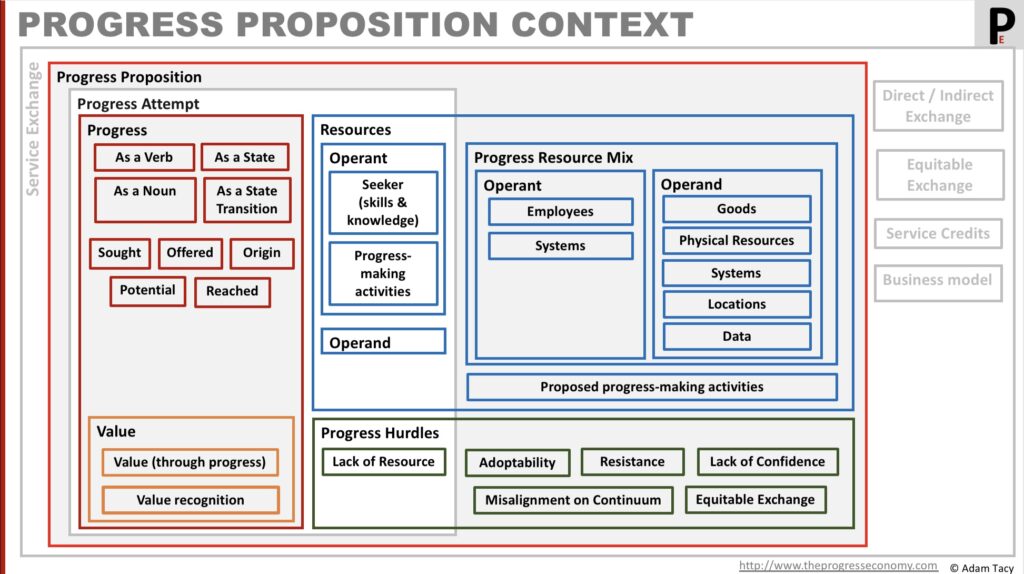
Innovation is all about improving progress and reducing progress hurdles. We create new propositions, or alter existing ones. Identifying, creating, or combining progress-making steps, resource mix compositions, and/or resource mix components.
What are progress propositions?
Progress propositions are bundles of supplementary resources offered by progress helpers. The dream is to help a seeker reach their individual progress sought with minimised progress hurdles.
Specifically, propositions comprise a:
- proposed series of progress-making activities – instructions, manuals, recipes, processes, etc
- progress resource mix – proposition specific mix of six types of resources
These resources are strategically designed to minimise a progress seeker’s lack of resource progress hurdle. Increasing their judgements of progress potential towards their progress sought and judgements of progress reached during a progress attempt. Ultimately allowing a seeker to recognise more value.
Progress attempts now become a joint endeavour with value emerging through co-creation between seeker and helper. Though some propositions see the seeker performing all the progress-making activities (enabling propositions); whilst in others the helper performs them all (relieving propositions). The majority of propositions sit on a continuum between these points.

Helpers can apply their competences in two main ways. Firstly a helper can apply their skills/knowledge to directly aid progress sought. The other way is they teach a seeker the skills/knowledge to later attempt progress on their own. Don’t try and catch me ought by asking what if the progress sought is to learn…then both approaches lead to same result.
Despite the positive aspects of progress propositions, they may not completely address the initial lack of resource progress hurdle and, in some cases, might introduce new resource challenges. Additionally, the existence of propositions introduces five more progress hurdles.
One final challenge lues in recognising propositions offer to help a seeker reach a state of progress offered. This likely differs from the seeker’s progress sought. The extent of this difference is a crucial factor in a seeker’s decision to engage a proposition. We’ll come back to this.
Proposition as a service
We can see the execution of a progress proposition as a service – following Vargo & Lush’s definition:
service: the application of competences (knowledge and skills) for the benefit of another party
Vargo & Lush (2008) “From Goods to Service(s): Divergences and Convergences of Logics”
As they are a service then we can stand on Grönroos’ definition of service to see why a proposition consists of a series of progress-making activities and a resource mix:
Where do they come from and why?
Propositions find their origins in seekers who have discovered, whether accidentally or intentionally, a way to make progress in a specific aspect of their progress sought. Having gained new resources (skills, knowledge, tools, etc), they feel that others may benefit from them offering those to make similar progress. In such a way, a seeker becomes a helper.
In other cases actors may apply their resources in deliberate attempts to improve progress for seekers even if they are not seeking that progress themselves. Now we’re talking R&D in existing helpers or entrepreneurs.
But what drives actors to offer propositions? It is their desire (or need) to engage in service exchange. This exchange might be direct between two actors. Though more often it is indirect, enabled by service credits. For example through transitive indirect exchange – I help you, you give me service credits, I use those credits not with you but with another helper. Or to support internal or ecosystem indirect exchange.
Putting propositions in context
Progress propositions inherit concepts from progress attempts.
Where the scope of resources available to the seeker widens, encompassing both a progress resource mix and a proposed series of progress-making activities offered by the progress helper.
While the primary aim of a proposition is to minimise the lack of resource progress hurdle, it may not eliminate it entirely and could potentially introduce new lack of resource.
Additionally, the proposition’s existence introduces five more progress hurdles.
Even though the seeker takes the lead in initiating the progress attempt, the execution of progress-making activities involves a collaborative effort between the seeker and the helper.
Let’s start exploring the key concepts that come with profress propositions. Starting with the progress they offer to help reach.
Progress offered
Propositions offer to help a seeker reach the state of progress offered.
Ideally, progress offered matches each individual seeker’s progress sought. However, for non-simplistic progress, the effort that requires from a helper translates into a higher equitable exchange request to engage. That usually increase the equitable exchange progress hurdle (one of the five new progress hurdles related to the existence of a proposition).
To illustrate, consider the effort a helper puts in to create a tailor made suit compared to an off-the-peg one. The tailor’s higher service effort warrants a more substantial service in return to be seen as equitable by both parties (which, if this is an indirect exchange, typically translates to a higher number of service credits).
The progress diamond helps us visualise this interface between progress offered and progress sought. And it is in the functional and non-functional elements that we see drifting. Currently we don’t see trade-offs in contextual progress.
Helpers elect to offer their progress offered based on strategic decisions. One approach is to segment the market on progress sought (a better approach than traditional ways) and then build one or more segment attractive offers.
By segmenting they look at both functional and non-functional aspects. That feeds directly into Porter’s Generic Competitive Strategies (differentiation vs cost). That is to say, helpers look at mainstream progress and decide which components can be decreased (cost) and which can be increased (differentiation). Supermarket self checkouts are a good example of getting this wrong.
Expanding on that, a helper can also add or remove progress components to the mainstream view. Now we’re talking about the main tool in Kim and Mauborgne Blue Ocean Strategy, aiming to identify markets that are uncontested.
Finally, sometimes seekers engage a proposition not originally intended for the progress being sought, but which the seeker sees as having an advantageous progress offered for their purposes.
Implications of mismatched progress offered and sought
The upshot of progress offered is that seekers find several propositions. Each offering to help them make varying amounts of functional and non-functional progress within a specified contextual progress. And each proposition comes with varying levels of six progress hurdles, mainly the equitable service exchange one.
We can visualise this situation as follows.
A seeker then needs to judge which proposition has:
- highest and sufficient progress potential (the best progress offered related to their progress sought)
- lowest progress hurdles
for them to make a progress attempt. In other words we have to update the progress decision process.
updating the progress journey decisions process
When engaging a proposition the seeker follows a slightly updated decision process. Now they also need to judge if the progress offered aligns closely enough with their individual progress sought.
We call this updated approach the proposition engagement process. Which you can compare to the earlier progress decision process below.


Now the start and continuation decisions include phenomenological decisions by the seeker on
Progress resource mix
One of the supplementary resource bundles in a progress proposition is the specific mix of resources offered to the progress seeker. These resources are intended to reduce the seeker’s original lack of resource (skills, knowledge, tools, strength, time, etc…).
During a progress attempt, progress is made through successful resource integrations between seeker’s resources and elements of the helper’s resource mix. In the progress economy we find there are six resources typically offered in the mix:
- Employees (operant)
- Systems (operant or operand)
- Data (operand)
- Goods – both physical and digital (operand)
- Physical resources – goods where ownership is temporarily transferred (operand)
- Locations (operand)
Not every resource type needs to be included in a particular mix; a single item like a nail can serve as a straightforward, one-item resource mix.
Here’s a couple of example mixes, in a useful way to visualise them:

The composition of the resource mix often sheds light on the nature of the proposition, indicating whether it leans toward enabling or relieving on the proposition continuum.
Altering the mix
Modifying the resource mix is feasible because resources carry capabilities, making them largely interchangeable, though not necessarily in a one-to-one ratio.
For instance, substituting an employee with a goods – such as a tradesman with a hammer – is a toy example of this interchangeability. Goods have the ability to freeze knowledge and skills, enabling their distribution, and are unfrozen during acts of resource integration.
This substitution not only shifts the proposition’s position on the continuum, now leaning towards enabling rather than relieving, but it also affects the supported non-functional requirements. Additionally, it places specific resource demands on the seeker, requiring knowledge, skills, and time, as illustrated in this example.
Proposed progress making activities
The helper’s proposed progress-making activities constitute another essential resource bundle in a proposition.
This aligns with the concept seen in a progress attempt, where a series of progress-making activities is undertaken; this time to achieve the progress offered, judged by the seeker as sufficiently close to their progress sought. Each progress-making activity is an act of resource integration.
In contrast to progress attempts, progress propositions introduce key distinctions:
- this series of activities is now proposed by the progress helper
- activities are performed by some combination of the seeker and helper
- resource integrations are some combination of seeker resources and supplementary resources in the proposition’s progress resource mix.
Here’s how the difference between a progress attempt with and without a proposition looks like.

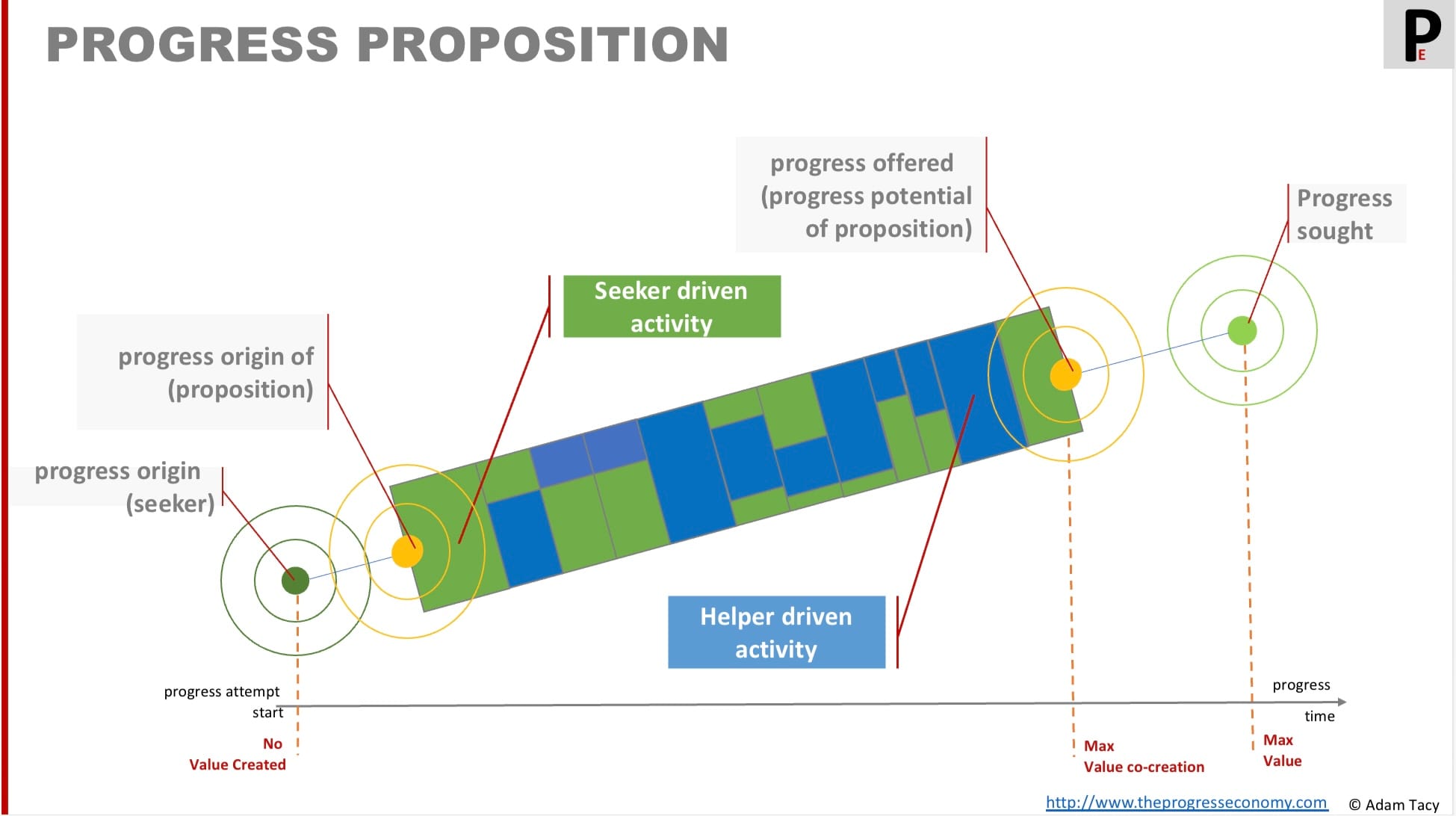
In our daily lives we encounter these proposed activities under more familiar names, such as:
- instructions
- operating manuals
- recipes
- processes
- contract terms etc
These proposed activities are often not mandatory for the seeker to follow. Seekers can opt to use their own devised activities. When was the last time you unboxed a new electrical device and read the manual before using? Although a helper may embed the activities within a system or outline them in a specific contractual manner to enforce their usage.
Just like with progress attempts, this series of progress-making activities is an operant resource; as such, service-dominant logic tells us they are a source of strategic benefit. The quality of the proposed activities directly influences progress and, consequently, the emergence of value.
Deviating from the suggested steps can be viewed as a misuse of resource, or lead to misusing other resources. That potentially leads to value co-destruction.
resource integrations
Service-dominant logic’s 9th foundational premise tells us that all actors are resource integrators:
All social and economic actors are resource integrators
#9
And this is exactly what we see In the progress economy. Both our main actors, seekers and helpers, integrate resources in order to make progress. For example:
- a patient (seeker operant resource) providing background information to a doctor (helper operant resource)
- a teacher (helper operant resource) educating a student (seeker operant resource)
- a customer (seeker operant resource) driving a hire car (helper operand resource)
- a technician (helper operand resource) repairing an object (seeker operand resource)
resource integration – a model
We can also build a model for how resource integration works. Luckily Gallouj & Weinstein (1997) provide such a model to which we can make some very simple tweaks. Below you can see this.
The intention being the final characteristics (far right) are what the seeker experiences. We can interpret those as the aspects of progress sought (or offered) elements. The functional, non-functional and contextual elements. They are achieved through various resource integrations between the items in the rest of the diagram.
The technical characteristics are the operant resources that when acted upon lead to aspects of progress. These are the goods, physical resources, data, locations, processes, systems (operant), and the series of progress- making activities.
On the left we find the skills and competences of the seeker and any helper employees and systems acting as operand resources.
Gallouj & Weinstein identify interesting aspects. Particularly that beneficial characteristics in helper employees are often captured as technical characteristics to ensure they are shared amongst other employees.
Role of the seeker in progress attempts
The seeker acts as Payne et al state in their paper on “Managing the co-creation of value” during lone progress attempt. That is to say they perform all the progress-making activities.
The customer’s value creation process can be defined as a series of activities performed by the customer to achieve a particular goal.
Payne, A. F., Storbacka, K., and Frow, P. (2006) “Managing the co-creation of value”
When progress attempts involve a proposition, the dynamics become more intricate. Although the seeker initiates the attempt, progress is a joint endeavour effort, with both seeker and helper likely to perform progress-making activities.
Bitner et al (1997) suggest a more firm-centric view, viewing customers (seekers) as partial employees of helpers during attempts. Storbacka and Lehtinen (2001) further elaborate on the role of customers having multiple roles:
a customer (payer), a consumer, a competence provider, a controller of quality, co-producers and/or co-marketers.
Storbacka and Lehtinen (2001) “Customer Relationship Management: Creating Competitive Advantage Through Win-win Relationship Strategies”
In the progress economy, the role of seekers varies depending on the positioning of the progress proposition along the continuum between enabling and relieving propositions.
At the enabling end of the continuum, seekers align with Payne’s perspective, actively performing proposed activities whilst co-creating value. In relieving propositions, seekers assume roles resembling consumers or controllers of quality, as the helper executes all activities, occasionally utilizing seeker’s resources. Whereas between these extremes, a collaborative effort unfolds, with both seeker and helper contributing activities and resources. In all cases, the seeker is the ultimate decision-maker regarding progress and recognising emerged value.
Introducing new hurdles
Whilst the intention of propositions is to address the lack of resource progress hurdle, they may not do so fully. And they may even create a new, different, lack of resource hurdle.
Say, for example, to meet a functional progress of travelling between cities, we offer fly yourself mini aircraft. We might offer a way of attempting progress. But we require the seeker to have skills and knowledge of flying the aircraft – likely a resource they lack.
The mere presence of a progress proposition brings about five additional hurdles that must be minimised.
We have to ensure the seeker feels they can use the proposition. For example it is simple and they can trial it. If you’ve studied innovation then this is Rodgers’ adoptability. And we need to minimise seekers deciding to resist the proposition. Think back to the resistance to nuclear power stations of the past.
| hurdle | description |
|---|---|
| adoptability | can the progress seeker easily envision themselves using the proposition? |
| resistance | will the progress seeker resist, postpone, reject, or oppose the proposition due to perceived risks, usage conflicts, traditions, norms, or image concerns? |
| misalignment on continuum | how far apart on the progress continuum (from enabling to relieving propositions) are the proposition and what the seeker is looking for? |
| lack of confidence | does the seeker trust the proposition and the helper behind it to assist them in reaching the offered progress state? |
| equitable exchange | how many service credits does a progress seeker need to get from elsewhere to engage proposition |
Yet another challenge emerges based on the position of the proposition along the continuum we’ve previously discussed. It turns out seekers also position themselves on the continuum when making a progress attempt. They may be looking for non-functional progress that is supported by a relieving proposition. If you’re offering only an enabling proposition, then you are far from what they are seeking.
The seeker’s confidence in your proposition and in you as a helper becomes important. Lower confidence means a higher barrier.
Lastly the seeker needs to feel they exchange of service they are about to partake in with you is equitable. Given most exchanges are indirect, the question the seeker is asking themselves is this: does the effort I need to give (or have given) in providing service elsewhere justify the effort I’m going to get from you.
Lastly, the seeker needs to feel that the exchange of service they are entering with you is equitable. Are they getting enough effort from you for the effort they are giving in return. Since most exchanges are indirect, seekers question is really are you asking for too many service credits for your help.
Relating to value
Fundamentally, propositions have no value. They offer potential value that emerges when progress is made using them. This view aligns with our foundation in service-dominant logic:
actors cannot deliver value but can participate in the creation and offering of value propositions
#7
Progress is now a joint endeavour of performing resource integration activities. Emerging value can then be seen as being co-created. We inherit from progress attempts that there’s no value before an attempt starts and maximum value when reaching a seeker’s progress sought. As Grönroos writes:
It is of course only logical to assume that the value really emerges for customers when goods and services do something for them. Before this happens, only potential value exists
Grönroos (2004) “Adopting a service logic for marketing”
Which leads to the concept of value-in-use. We prefer to say value-through-progress as this applies to progress attempts with and without engaging progress propositions.
value-through-progress: A view of value creation that sees value as being increasingly created as progress is made. Though this value may be recognised on a different schedule.
Let’s visualise progress and emerging value together:
As we know, a seeker recognises maximum value when they reach their progress sought. And we’ve discussed a proposition’s progress offered often doesn’t match progress sought. So maximum value co-created is usually different to maximum value creation. If it’s lower, the seeker needs to decide if it is sufficient to attempt.
When it is greater it is not always a great sign. That extra progress (value) may mean nothing to the seeker. And it may come at a “cost” of higher progress hurdles. This thinking feeds into Christensen’s disruptive innovation.
Alternatively, that additional progress may be something the seeker didn’t realise they needed. In which case, upon seeing it, it is likely their progress sought evolves to include it (meaning in their eyes it is no longer really additional value).
However, where there is value co-creation, there is the potential for value co-destruction. Which is where progress is being hampered by the action of the seeker and/or helper.
Relating to innovation
Payne tells us the following about helper competitiveness:
If a supplier wants to improve its competitiveness, it has to develop its capacity to either add to the customer’s total pool of resources in terms of competence and capabilities (relevant to the customer’s mission and values), or to influence the customer’s process in such a way that the customer is able to utilize available resources more efficiently and effectively
Payne, A. F., Storbacka, K., and Frow, P. (2006) “Managing the co-creation of value”
Which touches the two resource bundles of a progress proposition:
- progress resource mix – “add to the customer’s total pool of resources in terms of competence and capabilities (relevant to the customer’s mission and values)”
- proposed progress-making activities – “influence the customer’s process in such a way that the customer is able to utilize available resources more efficiently and effectively”
Innovation should focus on creating new, or altering existing, progress resource mix and progress-making activities so that a proposition offers some combination of:
- increasing a seeker’s progress potential (getting them closer to their progress sought)
- improving how to make existing progress better
- reducing one or more of the progress hurdles



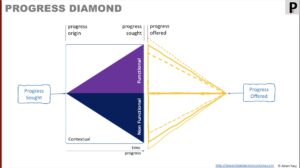


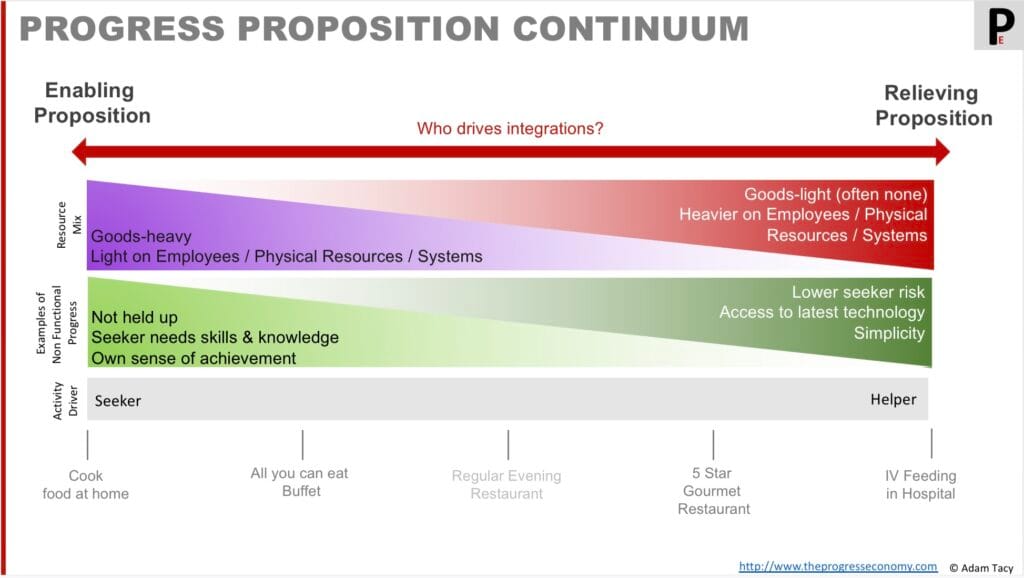
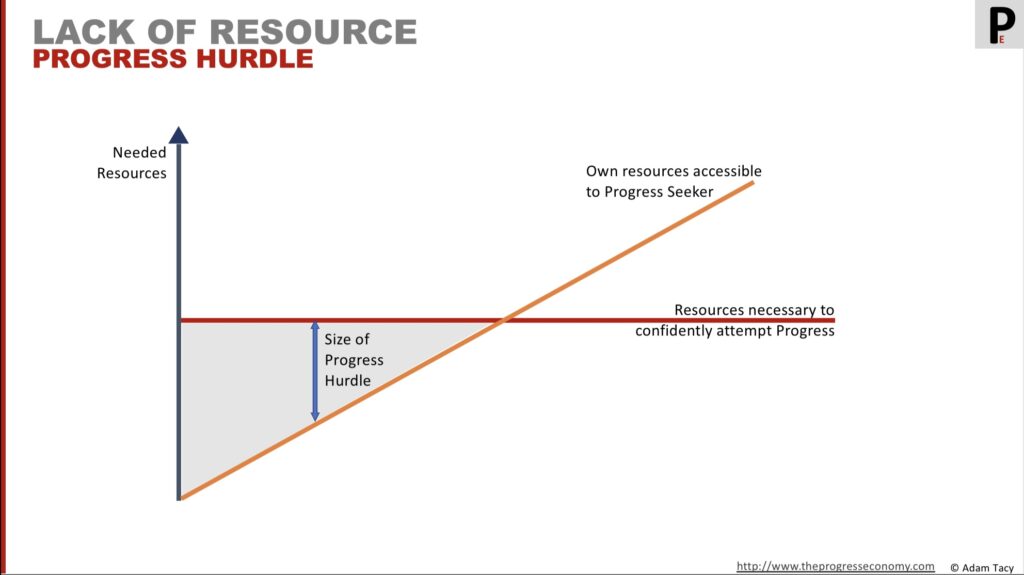
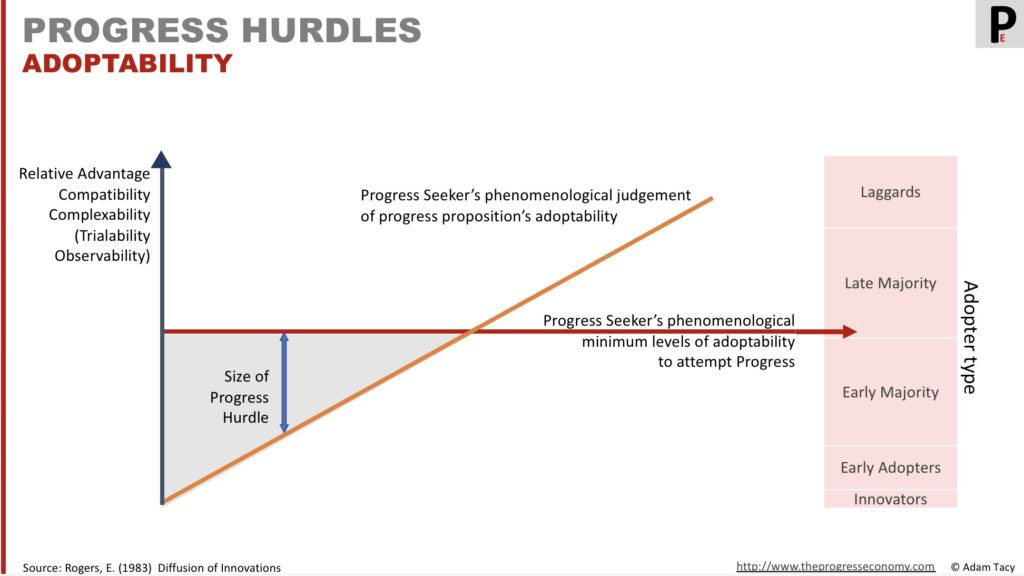


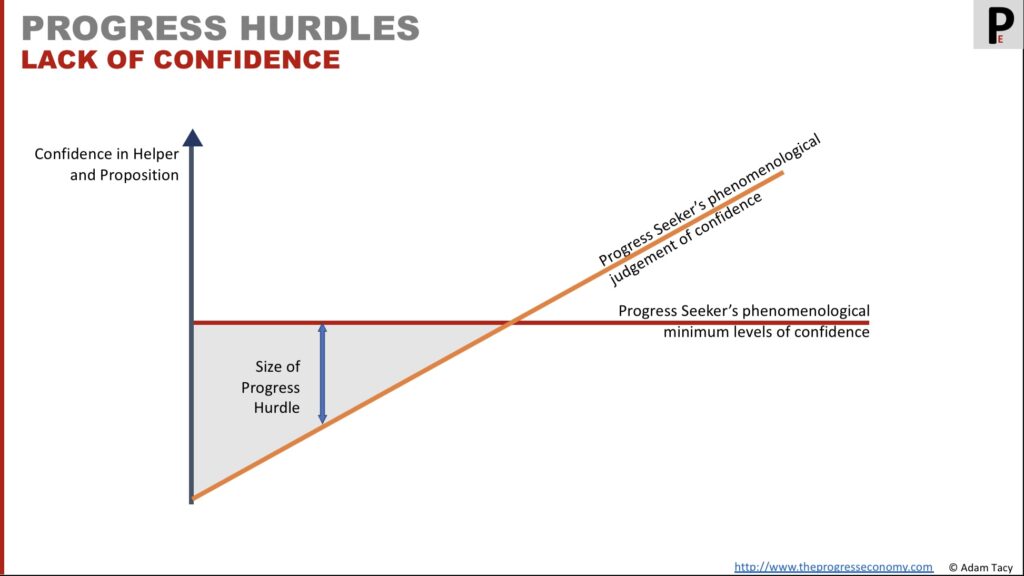


Let’s progress together through discussion…